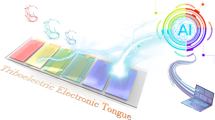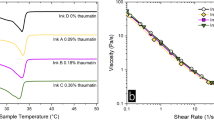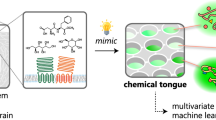Abstract
Infusing human taste perception into smart sensing devices to mimic the processing ability of gustatory organs to perceive liquid substances remains challenging. Here we developed a self-powered droplet-tasting sensor system based on the dynamic morphological changes of droplets and liquid–solid contact electrification. The sensor system has achieved accuracies of liquid recognition higher than 90% in five different applications by combining triboelectric fingerprint signals and deep learning. Furthermore, an image sensor is integrated to extract the visual features of liquids, and the recognition capability of the liquid-sensing system is improved to up to 96.0%. The design of this dual-sensory fusion self-powered liquid-sensing system, along with the droplet-tasting sensor that can autonomously generate triboelectric signals, provides a promising technological approach for the development of effective and low-cost liquid sensing for liquid food safety identification and management.
This is a preview of subscription content, access via your institution
Access options
Access Nature and 54 other Nature Portfolio journals
Get Nature+, our best-value online-access subscription
$29.99 / 30 days
cancel any time
Subscribe to this journal
Receive 12 digital issues and online access to articles
$119.00 per year
only $9.92 per issue
Buy this article
- Purchase on Springer Link
- Instant access to full article PDF
Prices may be subject to local taxes which are calculated during checkout






Similar content being viewed by others
Data availability
All relevant data are included in the article, Supplementary Information and the source data files provided with this paper. All the other raw data are available from the corresponding authors on request.
Code availability
The code is available from the corresponding authors upon reasonable request.
References
Vlasov, Y., Legin, A., Rudnitskaya, A., Di Natale, C. & D’amico, A. Nonspecific sensor arrays (‘electronic tongue’) for chemical analysis of liquids (IUPAC Technical Report). Pure Appl. Chem. 77, 1965–1983 (2005).
Gabrieli, G., Muszynski, M. & Ruch, P. W. A reconfigurable integrated electronic tongue and its use in accelerated analysis of juices and wines. In 2022 IEEE International Symposium on Olfaction and Electronic Nose (ISOEN) 1–3 (IEEE, 2022).
Zhu, Y. W. et al. Exploring the relationships between perceived umami intensity, umami components and electronic tongue responses in food matrices. Food Chem. 368, 130849 (2022).
Sochacki, G., Abdulali, A. & Iida, F. Mastication-enhanced taste-based classification of multi-ingredient dishes for robotic cooking. Front. Robot. AI 9, 886074 (2022).
Rodríguez-Méndez, M. L. et al. Electronic noses and tongues in wine industry. Front. Bioeng. Biotechnol. 4, 81 (2016).
Woertz, K., Tissen, C., Kleinebudde, P. & Breitkreutz, J. Taste sensing systems (electronic tongues) for pharmaceutical applications. Int. J. Pharm. 417, 256–271 (2011).
Winquist, F. et al. An electronic tongue in the dairy industry. Sensor. Actuat. B 111-112, 299–304 (2005).
Fan, F. R., Tang, W. & Wang, Z. L. Flexible nanogenerators for energy harvesting and self-powered electronics. Adv. Mater. 28, 4283–4305 (2016).
Lee, M. et al. Self-powered environmental sensor system driven by nanogenerators. Energy Environ. Sci. 4, 3359–3363 (2011).
Wang, X. D. et al. Self-powered high-resolution and pressure-sensitive triboelectric sensor matrix for real-time tactile mapping. Adv. Mater. 28, 2896–2903 (2016).
Zhong, T. Y. et al. An artificial triboelectricity-brain-behavior closed loop for intelligent olfactory substitution. Nano Energy 63, 103884 (2019).
Guo, H. Y. et al. A highly sensitive, self-powered triboelectric auditory sensor for social robotics and hearing aids. Sci. Robot. 3, eaat2516 (2018).
Yoon, H. J. et al. Mechanoreceptor-inspired dynamic mechanical stimuli perception based on switchable ionic polarization. Adv. Funct. Mater. 31, 2100649 (2021).
Qu, X. C. et al. Artificial tactile perception smart finger for material identification based on triboelectric sensing. Sci. Adv. 8, eabq2521 (2022).
Wei, X. L., Wang, B. C., Wu, Z. Y. & Wang, Z. L. An open-environment tactile sensing system: toward simple and efficient material identification. Adv. Mater. 34, 2203073 (2022).
Bachmanov, A. A. & Beauchamp, G. K. Taste receptor genes. Annu. Rev. Nutr. 27, 389–414 (2007).
Barretto, R. P. J. et al. The neural representation of taste quality at the periphery. Nature 517, 373–376 (2015).
Kwak, S. S. et al. Triboelectrification-induced large electric power generation from a single moving droplet on graphene/polytetrafluoroethylene. ACS Nano 10, 7297–7302 (2016).
Choi, M., Lee, W. M. & Yun, S. H. Intravital microscopic interrogation of peripheral taste sensation. Sci. Rep. 5, 8661 (2015).
Wei, X. L. et al. All-weather droplet-based triboelectric nanogenerator for wave energy harvesting. ACS Nano 15, 13200–13208 (2021).
Zhao, X. J., Zhu, G., Fan, Y. J., Li, H. Y. & Wang, Z. L. Triboelectric charging at the nanostructured solid/liquid interface for area-scalable wave energy conversion and its use in corrosion protection. ACS Nano 9, 7671–7677 (2015).
Pan, L. et al. Liquid-FEP-based U-tube triboelectric nanogenerator for harvesting water-wave energy. Nano Res. 11, 4062–4073 (2018).
Nie, J. H. et al. Probing contact-electrification-induced electron and ion transfers at a liquid-solid interface. Adv. Mater. 32, 1905696 (2020).
Lin, S. Q., Xu, L., Chi Wang, A. & Wang, Z. L. Quantifying electron-transfer in liquid-solid contact electrification and the formation of electric double-layer. Nat. Commun. 11, 399 (2020).
Ying, Z. H. et al. Self-powered liquid chemical sensors based on solid-liquid contact electrification. Analyst 146, 1656–1662 (2021).
Shi, Q. F. et al. Deep learning enabled smart mats as a scalable floor monitoring system. Nat. Commun. 11, 4609 (2020).
Wen, F. et al. Machine learning glove using self-powered conductive superhydrophobic triboelectric textile for gesture recognition in VR/AR applications. Adv. Sci. 7, 2000261 (2020).
Shi, Q. F. et al. Artificial intelligence of things (AIoT) enabled floor monitoring system for smart home applications. ACS Nano 15, 18312–18326 (2021).
Sundaram, S. et al. Learning the signatures of the human grasp using a scalable tactile glove. Nature 569, 698–702 (2019).
Rodriguez-Mendez, M. L. et al. Fusion of three sensory modalities for the multimodal characterization of red wines. IEEE Sens. J. 4, 348–354 (2004).
Simonyan, K. & Zisserman, A. Very deep convolutional networks for large-scale image recognition. Preprint at https://arxiv.org/abs/1409.1556 (2014).
Acknowledgements
This research was supported by the National Natural Science Foundation of China (grant number 61503051; Z.W.).
Author information
Authors and Affiliations
Contributions
Z.W. and Z.L.W. planned the study and supervised the whole project. X.W., Z.W. and Z.L.W. conceived the idea, analysed the data and wrote the paper. B.W., X.C. and H.Z. helped with the experiments. All the authors discussed the results and commented on the paper.
Corresponding authors
Ethics declarations
Competing interests
The authors declare no competing interests.
Peer review
Peer review information
Nature Food thanks Zong-Hong Lin and the other, anonymous, reviewer(s) for their contribution to the peer review of this work.
Additional information
Publisher’s note Springer Nature remains neutral with regard to jurisdictional claims in published maps and institutional affiliations.
Supplementary information
Supplementary Information
Supplementary Figs. 1–28, Table 1 and Note 1.
Supplementary Video 1
The dynamic of one water droplet captured by a high-speed camera (a front view).
Supplementary Video 2
A water droplet sliding down an inclined surface.
Supplementary Video 3
Simulation of droplet sliding along an inclined plane by volume fraction of fluid.
Supplementary Video 4
Simulation of droplet sliding along an inclined plane by velocity field.
Supplementary Video 5
The signal response triggered by a coffee droplet sliding.
Supplementary Video 6
The signal response triggered by a water droplet sliding.
Supplementary Video 7
The taste-sensing system effectively identifies different liquids in a real environment.
Supplementary Data
Source data for supplementary figures.
Source data
Source Data Fig. 2
Statistical source data.
Source Data Fig. 3
Statistical source data.
Source Data Fig. 4
Statistical source data.
Source Data Fig. 5
Statistical source data.
Source Data Fig. 6
Statistical source data.
Rights and permissions
Springer Nature or its licensor (e.g. a society or other partner) holds exclusive rights to this article under a publishing agreement with the author(s) or other rightsholder(s); author self-archiving of the accepted manuscript version of this article is solely governed by the terms of such publishing agreement and applicable law.
About this article
Cite this article
Wei, X., Wang, B., Cao, X. et al. Dual-sensory fusion self-powered triboelectric taste-sensing system towards effective and low-cost liquid identification. Nat Food 4, 721–732 (2023). https://doi.org/10.1038/s43016-023-00817-7
Received:
Accepted:
Published:
Issue Date:
DOI: https://doi.org/10.1038/s43016-023-00817-7



